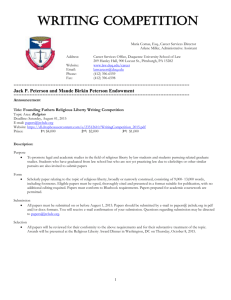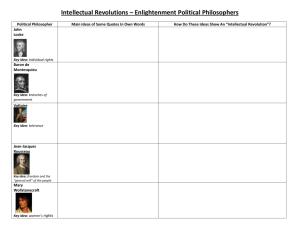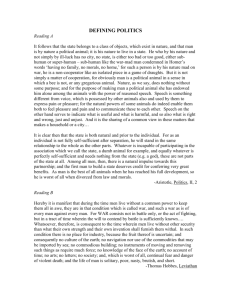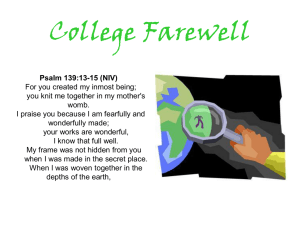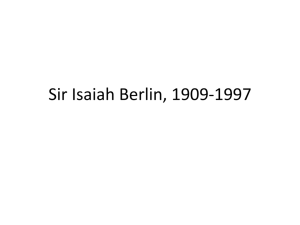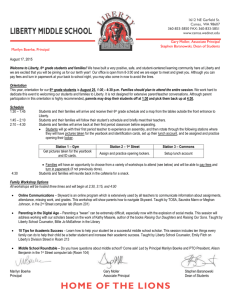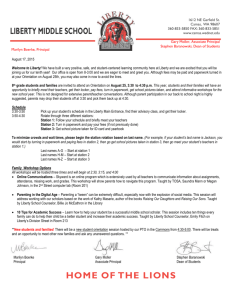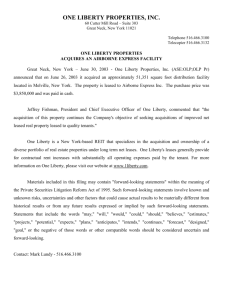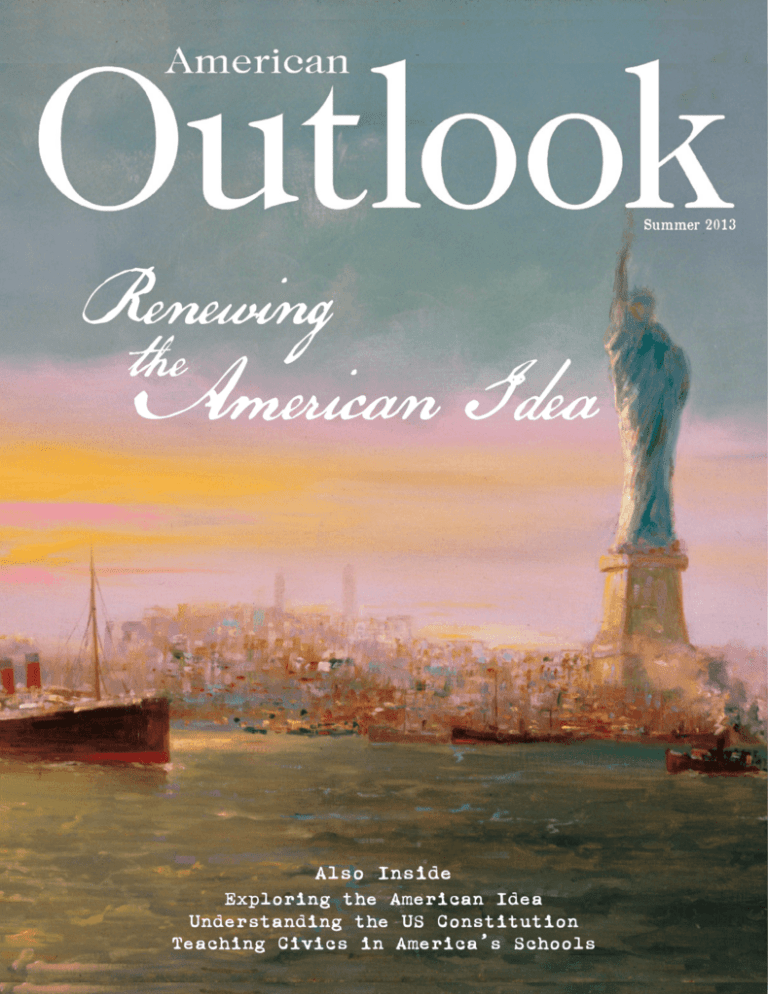
Summer 2013
Renewing
the
American Idea
Also Inside
Exploring the American Idea
Understanding the US Constitution
Teaching Civics in America’s Schools
American
Outlook
liam J. Bennett formed a partnership with Sagamore Institute to resuscitate the study of American
history. Dr. Bennett drew on his experience as U.S.
Secretary of Education and as the chairman for the
National Endowment for the Humanities as well
as his days teaching in university classrooms, to author a set of groundbreaking history textbooks. In
tandem, he recruited Sagamore Senior Fellow Rex
Bolinger to lead a team of nationally renowned educators to implement this new model in secondary
schools around the country.
Sagamore Institute was honored to assist Dr.
Bennett as he sought to “recapture the glory” and
“conviction about American greatness and purpose” in history. In the third section of this magazine, you can read more about this project entitled
“America: The Last Best Hope.”
As a think tank, Sagamore Institute is in the ideas
business. With our location in America’s Heartland, our Midwestern mindset drives us to put
those ideas into action. We aim to refresh the
American Idea for the next generation and to embed its principles into projects that will repair what
is broken in society and advance new solutions to
stubborn problems. Our work requires an informed
citizenry engaged in their communities and spheres
WN QVÆ]MVKM;IOIUWZMQV^Q\M[aW]\WRWQV][QV\PQ[
citizen-centered movement, which has been a central component of the American Idea throughout
our years as a republic.
Summer 2013
Vol. 13, No. 1
Jay F. Hein
Editor in Chief
Wesley Cate
Managing Editor
Beverly Saddler
Production Coordinator
Designer
Jonathan Haag
Web Editor
American Outlook is published
by Sagamore Institute, 2902 North
Meridian Street, Indianapolis,
Indiana 46208. 317.472.2050 www.
sagamoreinstitute.org. Copyright ©
2013, Sagamore Institute, Inc.
All rights reserved.
Sagamore Institute is an
Indianapolis-based nonpartisan
research group that brings
policymakers and practitioners
together to turn ideas into action.
Letters to the Editor:
Send all “Letters to the Editor” to
editor@sagamoreinstitute.org
Sagamore Institute
Board of Trustees
Chair
Jerry D. Semler
Jay F. Hein
President
Fall 2013
Jerry D. Semler
Chairman
Jay F. Hein
David L. Helmer
James T. Morris
Alex Oak
Donald L. Palmer
Stephen A. Stitle
Will Weaver
P. Douglas Wilson
Jean Wojtowicz
AMERICAN OUTLOOK | 3
10 | AMERICAN OUTLOOK
www.americanoutlook.org
Cover Feature
The Remnant Trust
“Great Ideas Belong to Everyone,” is the animating
belief of the Remnant Trust, a public educational
foundation aimed at increasing citizen’s understanding of individual liberty and human dignity.
Their mission is accomplished through the acquisition of historic documents, which are made available for the public to interact with. The collection
QVKT]LM[ÅZ[\MLQ\QWV[WN ¹<PM.MLMZITQ[\º)LIU
Smith’s “Wealth of Nations” and Mary Wollstonecraft’s “A Vindication of the Rights of Women”; it
also includes early printings of the Declaration of
Independence and the U.S. Constitution; one of the
three known copies of Thomas Aquinas’s “Summa
Theologica” and more. Its earliest documents
date back to 3000 B.C.
A Travelling Library
From 1778 to 1798 the bookseller James Lackington had a shop at No. 32, Finsbury Place in
London. The bookstore was sold in the early
1880s to Jones & Co., which mixed the collection with other books to create a travelling
library. Because books were too expensive for
most people to own at the time, this innovative
initiative brought important ideas to common
people. Fast-forward to today and most books
are easily obtainable today via public libraries,
used bookstores and Amazon.com. However,
the literary treasures of the past are often hidden in vaults inaccessible to the public. In the
spirit of the travelling library, Remnant Trust
obtains these treasures and puts them on display for ordinary citizens to inspect. Knowing
the works will depreciate from the interactions,
the only hoped-for return on investment is that
those ordinary citizens will be enthused readers
of the classics.
“
Questions of freedom and equality are of
fundamental importance today as they
have been throughout
the course of human history. The
challenge today is to
prepare this generation to draw on the
accumulated experience
of the past in order
to deal with the same
questions in the new
circumstances of the 21st
century.
Dr. John W. Ryan
Fall 2013
”
AMERICAN OUTLOOK | 11
Jeffersonville, Indiana was built in 1802
using a grid pattern created by Thomas
Jefferson. During the time it located its
collection in the Carnegie Library there,
Remnant Trust sponsored the creation
of a bronze wall along the Ohio River
celebrating historic figures.
“
a
12 | AMERICAN OUTLOOK
a nation expects to be
“ Ifignorant
and free.. it Expects what
never was and never will be.
”
Thomas Jefferson
hands-on
oppurtunity of
a lifetime.
”
www.americanoutlook.org
Cover Feature
In 1977 The Remnant Trust, Inc. was founded
when Brian Bex sought the help of his old friend,
Indiana University president Dr. John W. Ryan,
QVKWVÅZUQVO\PM^ITQLQ\aWN IÅZ[\MLQ\QWV
of Adam Smith’s Wealth of Nations. The Trust feels
this book does the best job of simplifying and
explaining the thoughts of Smith, who combined
the examination of economics with moral and
political philosophy.
Bex’s guiding philosophy for the Trust is grounded in two principles, “Great ideas belong to every-
Fall 2013
one” and “People collect this stuff and keep it in
basements out of sight. We loan for use original
works in original form that literally for centuries
have been locked up in vaults accessible only to
the privileged few.” It was these philosophies that
propelled the vision of The Trust to provide a
“hands-on” experience to educate for liberty and
dignity of the individual. Bex explained, “If we
can regenerate the ideas of liberty - for all people
- then our efforts will be valuable.” This vision of
the organization makes it unlike any other in the
nation.
AMERICAN OUTLOOK | 13
Remnant Trust Books on Display
During the month of September 2013, Sagamore Institute has had the honor of hosting an exhibit of
great works from the Remnant Trust, which is now being displayed at the Liberty Fund’s Constitution
Day Symposium. Below are brief descriptions of some of the works on display and how they have
contributed to the shaping of the American idea.
Adam Smith’s the Wealth of Nation’s
The Wealth of Nations by Adam Smith was published in 1776 in
;KW\TIVL<PMJWWSXZW^QLMLWVMWN \PMÅZ[\KWUXTM\MLM[KZQX\QWV[
of what builds a nation’s wealth, and over time it has become a fundamental work in classical economics. The Wealth of Nations was
written at the beginning of the Industrial Revolution, and it visits a
range of topics such as the division of labor, productivity, and free
markets.
Time has shown The Wealth of Nations to be one of the most
QUXWZ\IV\MKWVWUQK_WZS[WN ITT\QUMIVLQ\[QVÆ]MVKMWVXWTQ\QKIT
leaders reaches from the time of its publishing to this very day.
Thomas Paine’s Common Sense
Common Sense_I[IXIUXPTM\\PI\_I[ÅZ[\X]JTQ[PMLIVWamously in 1776 at the beginning of the American Revolution. The pamphlet was written to convey arguments for
the Revolution in common language so that its message
could be understood by all. The pamphlet became wildly
popular, and, relative to population, it had the largest sales
of any American book in history; an estimated 500,000
KWXQM[_MZM[WTLL]ZQVOQ\[ÅZ[\aMIZQVXZQV\*MNWZM+WUmon Sense was published, most people were on the fence
about a revolution. However, after the ideas in Common
Sense spread to the 2.5 million American colonists, a clear
decision had been made in the minds of the people.
14 | AMERICAN OUTLOOK
www.americanoutlook.org
John Locke’s Two Treatises of Government
In 1689, John Locke published his works of political philosophy anonyUW][TaQV-VOTIVL?PQTMJW\P\ZMI\Q[M[XZW^MLQVÆ]MV\QIT\PM;MKWVL
<ZMI\Q[MKZMI\MLIUWZM[QOVQÅKIV\QUXIK\WV\PQVSMZ[WN PQ[LIa1VQ\
Locke claims that civil society was created to protect “property”, which
includes “life, liberty, and estate.” Essentially, Locke argues that political
society is meant to protect individual rights and that it is not meant to
promote general good that is only evident on a societal level, such as societal virtues. Locke even saw this piece of the social contract as an obligation of the people, a perspective which prompted many of his contemporaries to throw their support on the side of the Revolution.
The Federalist:
Alexander Hamilton, James Madison and John Jay
The Federalist is a collection of 85 essays written by Alexander
Hamilton, James Madison, and John Jay. The Federalist Papers originated as a response from Hamilton to a series of papers called the
Anti-Federalist Papers, which criticized the newly written Constitution. When they were published, The Federalist Papers were
important works and represented one side of the political debate
QV\PMQZLIa0W_M^MZ\PMQZQVÆ]MVKMPI[M`\MVLMLNIZQV\W\PM
future, and the papers have been quoted 291 times in Supreme
Court decisions from 1798 to 2000. The words of The Federalist
are still intriguing today, and they convey the political philosophy
of three of America’s founding fathers in a thorough manner.
Narrative of the Life of Frederick Douglas
Narrative of the Life of Frederick Douglass is both a memoir and treatise on abolition written by former slave Frederick Douglass 1845. The book has been
KZMLQ\MLI[WVMWN \PMUW[\QVÆ]MV\QIT_WZS[NWZ\PMIJWTQ\QWVQ[\UW^MUMV\WN the 1800’s, waking many Americans to the importance of abolition and the
horrors of slavery. The Narrative of the Life of Frederick Douglass opened
the eyes of many Americans to the horrors of slavery and the evil of subjecting a human life to such conditions. The narrative earned Douglass the
respect and freedom he had sought his whole life, even as it spurred on the
abolitionist movement that was sweeping across the nation.
Magna Carta
Magna Carta, Latin for Great Charter, was issued in 1215 by a group of EnOTQ[PNM]LITJIZWV[\WTQUQ\\PMXW_MZWN \PM3QVO1\UIZSML\PMÅZ[\\QUMI
King of England was forced by his subjects to stamp his seal on a document,
and it proved to be a landmark historical event for the protection of the common people by limiting centralized government power. When the Founding
Fathers created our American system of government, they built it upon the
bedrock of liberty-minded ideas espoused in the Magna Carta, which was it[MTN _I[QVÆ]MVKMLJa\PM+PIZ\MZWN 4QJMZ\QM[NZWU_PQKPTQUQ\ML3QVO
Henry’s powers in certain ways. The idea of separation of power in governUMV\PI[JMMVSMaQV\PMNW]VLQVOIVLÆW]ZQ[PQVOWN \PM=VQ\ML;\I\M[
Fall 2013
AMERICAN OUTLOOK | 15
Liberty Fund and Remnant Trust
in Austria
The following books from the Remnant Trust collection
were made available at a Liberty Fund conference in
Vienna, Austria in 2011:
1.
2.
3.
4.
5.
6.
7.
8.
9.
10.
Title: Cato’s Letters
Title: Minutes of the Second Continental Congress
Title: Letters from an American Farmer
Title: Virginia General Assembly
Title: The Federalist
Title: Two Treatises of Government
Title: Common Sense
Title: Democracy in America
Title: Magna Carta
Title: A Speech, intended to have been delivered in
the House of Commons, in support of the petition
from the General congress at Philadelphia
11. Title: English Constitution. Touching the fundamental
Lawes, or politique constitution of this Kingdome, the
Kings negative Voice, and the Power of Parliaments.
To which is annexed, the Privilege and Power of the
Parliament, touching the Militia
12. Title: US Constitution
13. Title: Universal Magazine of Knowledge and Pleasure
Constitutions at a Turning Point
by Chris Talley
Liberty Fund President Chris Talley delivered these remarks in Vienna Austria
in 2011.
The documents selected here represent those themes of
western political understanding that became the core of
what is broadly considered the American constitutional
tradition. That tradition built upon a much older set of
ideas that had their roots in English and European ideas
about the nature of liberty and political power.
16 | AMERICAN OUTLOOK
With Magna Carta (1215) the rights of the governed
were successfully asserted over the royal claims of a
centralizing monarch. That victory on the banks of the
Thames encapsulated a larger European ideal of the
rule of law and the belief that every power ought to have
QV[\Q\]\QWVITKPMKS[]XWVQ\\WMV[]ZMÅLMTQ\a\W\PI\QLMIT
Locke elaborated on that idea in his Two Treatises
WV/W^MZVUMV\!_ZQ\QVOVMIZTaÅ^MKMV\]ZQM[TI\MZ
Rather than surrendering all rights to the prince, the
people retained those liberties that ensured their personal
freedoms, their rights to “life, liberty, and property.”
Cato’s Letters of Trenchard and Gordon carried this
idea forward in the 1720s, comprising an extensive and
extended critique of government and the corrupting
tendencies of power that reached throughout the British
Empire.
It was from these sources that Americans took inspira\QWVJMKI][M\PMaINÅZUML\PMQZW_VTQ^MLM`XMZQMVKMWN self-government under colonial charters and covenants
of their own making. Each governor and council, each
assembly and representative was held to the law by the
check of the other branches.
It was this experience of personal and political liberty
that prepared the way for American Independence
and the enormous success of Tom Paine’s Common Sense
_PQKPZMIKPML\W_MTTW^MZKWXQM[QV\PMÅZ[\
three months of its publication in 1776, and over half a
million by the end of the year.
Paine captured the essence of the American experience by noting at the very outset of his essay the important distinction between society and government. It was
from the former that Americans understood the idea of
happiness.
Happiness was to be found in a society of free individuals enjoying their essential rights and associating
voluntarily for all manner of purposes of trade, fellowship, faith and philanthropy. “Society,” wrote Paine, “is
produced by our wants, and
government by our wickedness; the former promotes our
happiness positively by uniting
our affections, the latter negatively by restraining our vices.
The one encourages intercourse,
the other creates distinctions.
<PMÅZ[\Q[IXI\ZWV\PMTI[\I
punisher. Society in every state is
a blessing, but government even
in its best state is but a necessary
evil...”
www.americanoutlook.org
That idea of happiness in a free society is what Jefferson placed in the opening paragraphs of the document
that inaugurated the political life the United States.
1\_I[\PM^MZaINÅZUI\QWVIVLVW\IVMOI\QWVWN \PM
essential rights of a free society that he presented in the
Declaration when he wrote,
“We hold these Truths to be self-evident, that all
Men are created equal, that they are endowed by
their Creator with certain unalienable rights, that
among these are Life, Liberty, and the Pursuit of
Happiness.”
When government is no longer conducive to the
happiness found in a free society, it is, Jefferson went on,
the people’s “Right, it is their Duty, to throw off such
Government, and to provide new Guards for their future
Security.”
The Constitution of the United States was intended
to create those “new Guards for their future Security.”
The Federalist Papers presented that argument to the
American people, and Hamilton, Madison and Jay made
it the core of their arguments.
Majorities would predominate in the new system,
but they had to be tempered by a respect for individual rights. To that end, checks and balances within the
institutions of government would be preserved and
extended in the Constitution, including federalism and
the separation of powers at both national and state levels.
It was in this fashion that liberty and the happiness of a
free society would be protected against the abuses and
corruptions of power.
It is for the purpose of understanding that tradition
of freedom and its institutions that Pierre Goodrich instituted Liberty Fund. It is also the mission that animates
the Remnant Trust’s generosity in presenting this marvelous collection of core documents in the history of liberty.
Fall 2013
History of Liberty Fund Conferences
Liberty Fund’s conference program began with a series
of conferences directed by the founder, Pierre Goodrich,
during the 1960s and early 1970s. These conferences set
a direction for the institution, keeping central themes at
the core and expanding into diverse but related areas.
One of Liberty Fund’s early successful conference
series was a bicentennial program of conferences concerned with the American Founding and its implications
for today. Around the same time, Liberty Fund was
QV[\Z]UMV\ITQVXQWVMMZQVO\PMÅMTLWN TI_IVLMKWVWUics by sponsoring conferences that brought to the table
scholars from those disciplines. In the more recent past,
Liberty Fund has done a series in Austrian economics,
annual week-long conferences that consider the entire
corpus of Adam Smith, and two separate series of conferences on the topic of education in a free society.
The essence of Liberty Fund’s conference program
\PZW]OPW]\Q\[ÅZ[\PITNKMV\]ZaPI[JMMVLQ[KZM\MKWVferences organized in coordination with hundreds of
different scholars on a wide array of topics in law, religion, history, literature, science, political theory, the arts,
journalism, and the key thinkers of Western civilization.
During this period, Liberty Fund’s program expanded
beyond North America to virtually all parts of the globe
but especially the United Kingdom, Europe, and Latin
America. Liberty Fund has a long and rich association
with the academic community, as well as business leaders, medical professionals, lawyers, and others outside the
academy. In 2004, Liberty Fund expanded the scope and
format of its conference activities with a new program
that coordinates with co-sponsoring institutions.
Liberty Fund moves into its second half-century
continuing to look for new avenues to explore issues of
liberty and responsibility while maintaining the perennial programs and values for which Liberty Fund was
established.
AMERICAN OUTLOOK | 17
Pulliam Family Great Books Gallery
A Look at the Cornerstones of Freedom
“As partners in freedom,
the people and the press
can save liberty.
The Newseum in Washington, D.C. opened
its doors to the public in 2008. The impressive, seven-level building consists of galleries,
exhibitions and multimedia experiences that
explore the history of journalism in the world.
The Newseum contains a gallery of the “500
years of recorded news, 15 theaters through
the building, television feeds from around the
world, current front pages of 80 newspapers,
a memorial to journalists killed reporting the
news and a space devoted to Pulitzer Prize
photographs,” according to the Washington Post.
Among the halls and exhibitions is the Pulliam
Family Great Books Gallery dedicated to the
democratization of ideas. The gallery features
historic books and documents provided by the
Remnant Trust and are considered the corner-
18 | AMERICAN OUTLOOK
”
stones of freedom, such as the Magna Carta
and the Federalist Papers. Visitors can also access dynamic online material investigating the
First Amendment’s freedom of the press. The
Great Books gallery is a recent manifestation
of the Pulliam Family’s longtime commitment
to philanthropy and freedom.
“Eugene Pulliam has been called the last of a
breed,” reads the Eugene C. Pulliam’s entry
in the Encyclopedia of American Journalism.
“Men who loved newspapers for their own
sake and their power as bully pulpits, rather
\PIVI[ÅVIVKQITQV^M[\UMV\[IVL_PW_MZM
outspoken defenders of press freedom. They
were entrepreneurs who were motivated not by
money, but by their beliefs in Christian morals
and human progress.” Upon receipt of the
www.americanoutlook.org
Cover Feature
Alexander Hamilton ponders the technology of the
21st Century, Newseum
Arizona Newspaper Association’s Peter Zenger
Award in 1965, Pulliam captured his family’s
mission by remarking, “As partners in freedom,
the people and the press can save liberty. If
newspapers can recognize responsibility, as
well as opportunity, to print the truth, refuse to
be intimidated, refuse to bow to government
bureaucracy, then they will serve the highest
cause of civilization, which is individual freedom—freedom of choice, and the right of free
expression.”
?Q\PPQ[]VÆQVKPQVOJMTQMN QVNZMMLWUIVL\PM
power of the press, Pulliam (now deceased)
helped to build American journalism. In 1909
Eugene and nine DePauw University classmates established a journalism fraternity that
would eventually become the Society of Professional Journalists. He and his heirs would also
mirror the efforts of Pierre Goodrich to use
their private enterprise for the public good.
The Pulliam Great Books Gallery is located
across from the U.S. Capitol representing another Indiana national treasure. It also extends
the family’s love for news reporting and freedom into the 21st century.
Fall 2013
AMERICAN OUTLOOK | 19
Great Ideas Belong to Everyone
A partnership between Liberty Fund, Sagamore Institute
and Remnant Trust to advance the study of the great books
of western civilization that combine to forge the American
constitutional tradition


